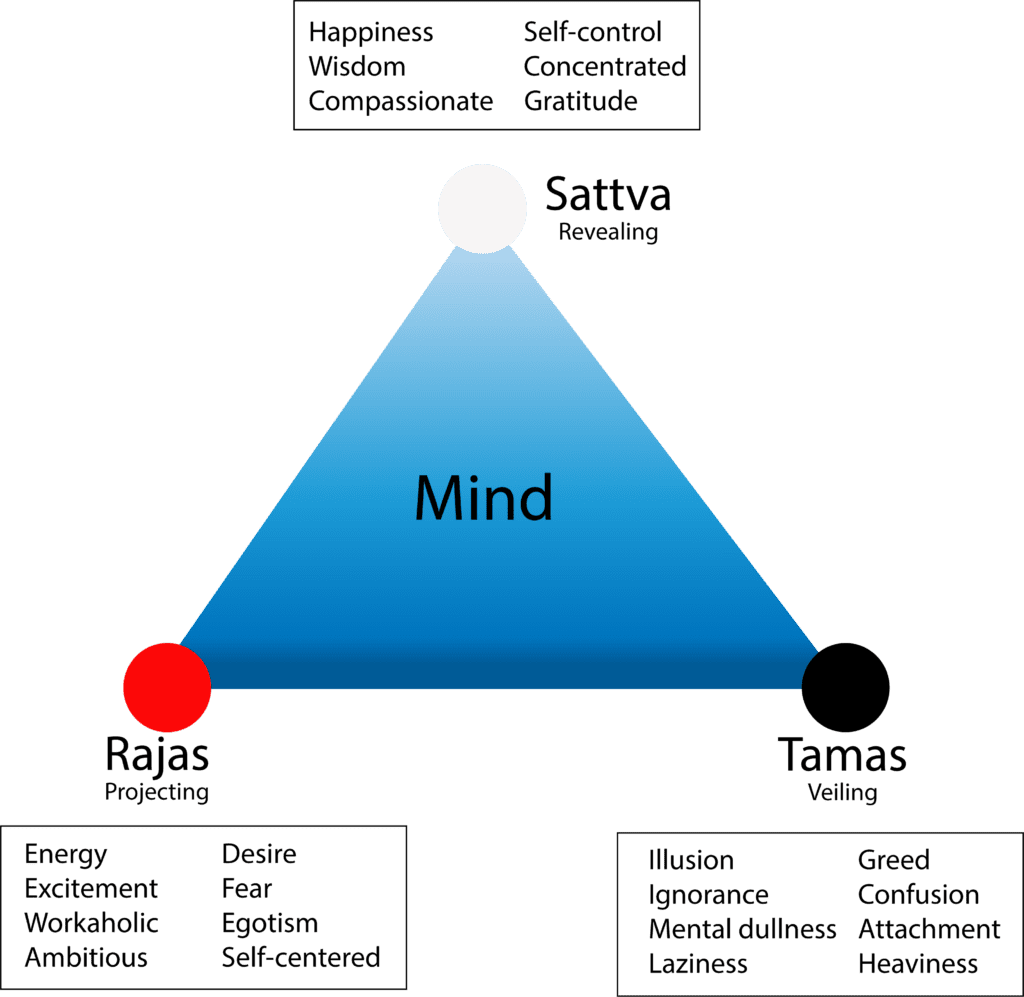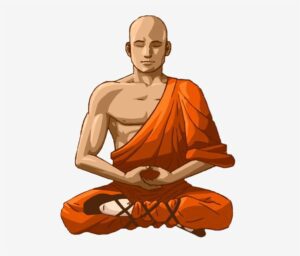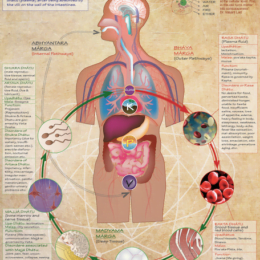The Gunas – Mental Constitution

Overview
In addition to the three Doshas that form the physiological constitution, Ayurveda recognizes three psychic energies, or Gunas, that comprise the mind and determine your psychological character. When the three Gunas are balanced, they keep the mind and body healthy. An imbalance, however, can produce mental and physical disorders.
- Sattva (Lightness or awareness): Illuminating, pure and good, which leads to clarity and mental serenity.
- Rajas (Action or activity): Mobility or activity, which makes a person active and energetic, tense and willful.
- Tamas (Stability or inertia): Dark and restraining which obstructs and counteracts the tendency of Rajas to work and Sattva to reveal
At any time, only one Guna can dominate a human being, but for a happy and complete life, it is ideal to strive for a balance in the three Gunas.
Sattva
Manifests itself as lightness of being, clarity of mind and purpose, perception of wisdom, and acquisition of knowledge. Sattva individuals are spiritual leaders, teachers, and healers. Noble, spiritual, and wise, the Sattva mind represents the culmination of human evolution. It is the mind illumined by the spirit.

Rajas
Represents the world of action, movement from the darkness of Tamas into the light. But the mind in Rajas is easily fooled by illusion, and those suffering from an imbalance of Rajas often succumb to ambition, greed, lust, materialism, and a desire to control and dominate. Our society is overwhelmed by the Rajas mindset.

Tamas
Is the state of mind dominated by density and inertia. An imbalance of Tamas causes apathy, lethargy, delusion, and drowsiness. In severe instances, these can turn to hate, vindictiveness, addiction, perversion, and other forms of self-destruction.

Effects of Gunas on the Mind
Among the three, Rajas and Tamas are called mental Doshas.
- If imbalanced, they may cause disease
- Sattva does not cause disease
- Gunas can be altered
- Gunas can become Sattvic, thereby improving health
Mental Qualities
Sattva
Description: Sattva is a quality of intelligence, harmony, balance and stability. Directing inward and upwards, it brings about the awakening of the soul. Sattva creates peace, everlasting happiness and contentment.
Mind: Kind, compassionate, loving, forgiving, truthful, intelligent, strong
Qualities: Harmony, balance, clarity, purity so doesn’t cause disease.
Rajas
Description: Rajas is the quality of change, activity, stimulus and turbulence. Raja is the motivation for action, ultimately to achieve power, control and dominance. It is directed outward causing egoistic actions. Rajas makes person fulfill his desires, which at the end causes pain and suffering. Most of the people live in this state for the whole life.
Mind: Egotistic, self-centered, greedy, angry lustful, violent, anxious, arrogant
Qualities: Movement, action, turbulence. Causes racing, restless, agitated mind, anxiety, stress, tension.
Tamas
Description: Tamas is the quality of darkness, inertia, obstruction, heaviness,
ignorance, lack of awareness, excessive sleep. It functions as a force of gravity, retarding things. It directs downwards and causes decay, death and disintegration.
Mind: Fearful, depressed, dull, miserable, delusional
Qualities: Inertia, darkness, dullness, heaviness Causes depression, fear, nervousness.
Balancing Tamas
Tamas guna can make it difficult for one to reach higher levels of consciousness. But you can bring the following changes in your life to balance the tamas guna.
- Stay away from Tamasic foods like meat, onion, garlic, etc., instead, try to eat fresh minimally prepared fruits and vegetables.
- Do sun salutations.
- Practice Kapalbhati pranayama.
- In a tamasic state try to slowly start your yoga practice and then gradually work it up to a more energetic one.
- Practice backbends and balancing poses. Reduce forward bends and resting poses like Shavasana.
- Practice Nadi shodhan for a mild amount of tamas, Kapalbhati for moderate amounts, and Bhastrika for high amounts of tamas.
- Avoid over-sleeping and try to get up early in the morning. Increase your overall physical and mental activity.
- Avoid inactivity, watching TV, and fearful situations.
- Refrain from overeating and try to consume a light diet with as many fresh fruits and vegetables.
- As you try to move away from tamas, make sure not to move too much towards the rajasic state. Once your tamasic guna is balanced, move your focus and attention towards cultivating the energy of sattva.
Balancing Rajas
Rajasic guna is helpful for yoga practitioners who want a more stimulating practice, for athletes and people who live in humid climates. However, having too much rajasic energy can cause exhaustion, stress, anger, obsessions, etc. This makes it difficult for one to transcend towards sattva guna. You can balance your rajasic guna by bringing few changes in your lifestyle.
- Practice gentle breathing techniques like Sitali or cooling breath or Nadi Shodhana (alternate nostril breathing). These can help you cool down and clear your mind.
- Stay away from spicy and fried foods, and eat a lot of leafy vegetables.
- In a Rajasic state also don’t go straight into a meditative or restorative practice with a restless or agitated mind, instead, start with steady and energetic practice and gently slow down to a calmer state of being.
- Practice forward bends and side bending poses like Utthita trikonasana, Parighasana, and Parivrtta Janu sirsasana. Approach your yogic practice with self-compassion to attain balance and calm and not forcing something that you don’t feel.
- Catch with your sleep and rest.
- Avoid busy and stimulating environments, instead seek out places that promote stillness, calmness, and contemplation.
Increasing Sattva
We need to follow a Sattvic lifestyle which includes consuming a Sattvic diet, developing the sattvic mindset, and indulge in Sattvic activities to cultivate Sattva Guna.
- Eat fresh foods and a plant-based diet that is local and organic.
- Consume foods that could be easily digested and provide us strength and vitality.
- Take proper sleep. Sleep early and wake up before the sunrise to get prana or life-force energy
- Develop a sense of gratitude. Thankfulness for what we have removes both lacking and the need for more.
- Spend more time in nature away from technology.
- Develop a sattvic state of mind through meditation and yoga.
- Immerse yourself in positivity, insight, and clarity.
- Speak the truth and avoid hurting anyone’s feelings.
- Practice Bhakti Yoga to elevate your consciousness quickly.
- Practice mindfulness. Try to live in the present moment and be aware of your feelings, emotions, physical and mental states without being judgemental. Mindfulness can help you avoid self-criticism and recognizing and managing difficult emotions.
- You can practice mindfulness through meditation and many other smaller tasks or moments like eating, walking, talking, showering, etc., throughout the day.
- Practice eating mindfully and with awareness and acceptance. Eating with awareness nourishes not only your body but your spirit as well. Mindful eating entails observing how you eat, how the food makes you feel, understanding your body’s cues of hunger, taste, satiety, and fullness. Mindful eating requires acknowledging instead of judging your thoughts and bodily sensations.
Conclusion
You have the ability to consciously alter the levels of Gunas in your minds and bodies. By understanding what causes Tamas and Rajas and tweaking our lifestyle you can reduce their effect and cultivate Sattva in your bodies and mind. Moreover, cultivating sattva by what we eat, think, speak, practice, over time results in moving towards a life of balance, clarity, peace, and purity.
Visit a Holistic Ayurvedic Coach
Talk to a Holistic Ayurvedic Coach to see if you how your Guna/Mental Constitution is compared to the Ayurveda Definition of Health and how simple diet and lifestyles changes can improve it.

Free 60 Minute Consultation
Completely free of charge, 60 Minute Consultation

Dietary Advise
Advise on dietary choices based on Doshas and the six tastes

Daily Routines
Create daily and nightly routines based on constitution, age and the seasons

Ayurvedic Principles
Ayurvedic principles including the holistic view of health, the elements, Doshas

Location
Online meeting, phone call or in person at coffee shop/park nearby Charlottesville, VA

Yoga Advise
Recommend yoga and yogic practices for improved health, including pranayama/breathwork





